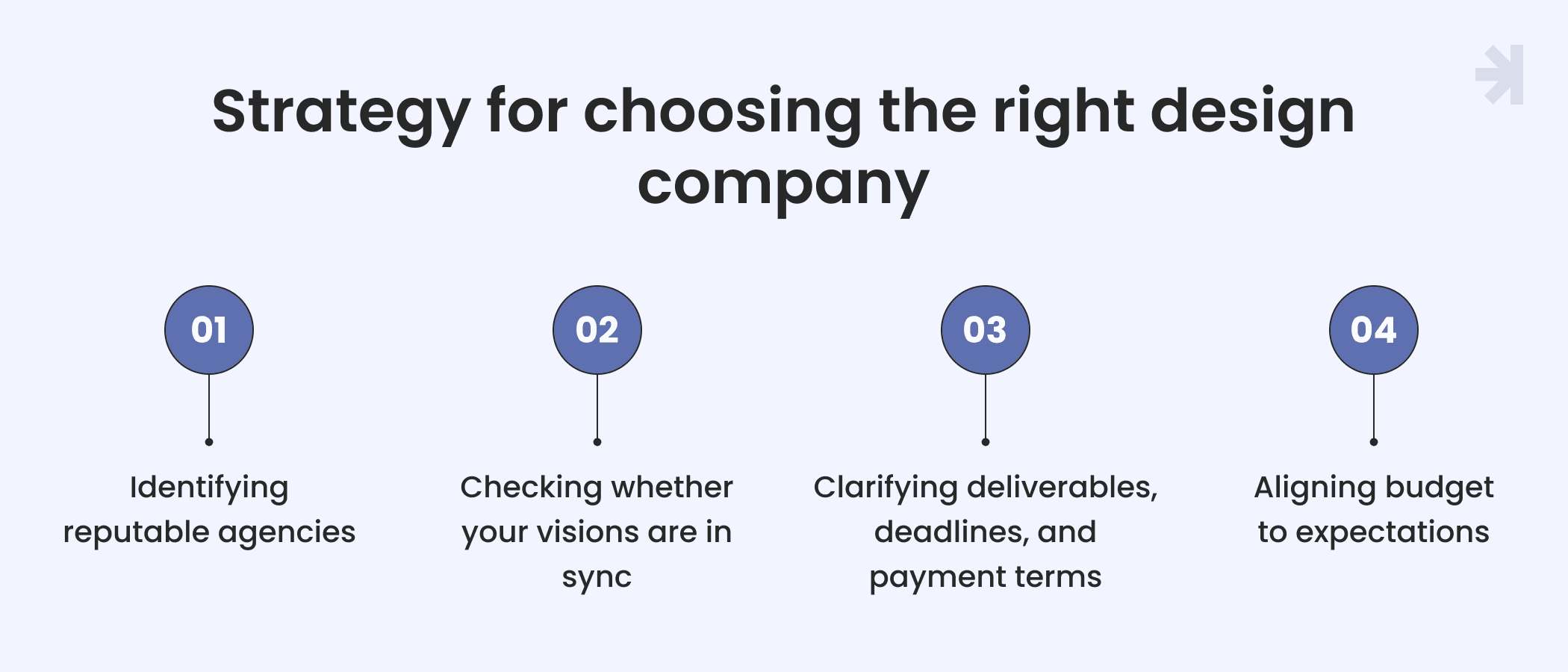Selecting a design agency these days can be pretty confusing for business owners. Endless alternatives! Branding solutions providers, web design firms, UI/UX agencies. Where do you even begin? Finding that perfect design partner is so important — but also so tricky. As a top UI/UX design agency, we want to provide an insider’s perspective on selecting the right company. In this article, we’ll explore the types of design firms and explain how to make an informed decision when choosing the best design partner for your business needs.
Overview of design agencies
While all design firms share the core objective — resolving business challenges through design — their services can differ significantly. When seeking design services for your business, you may come across multiple namings: graphic design, branding, creative, web design companies, etc. Let's decode the puzzle and figure out what kind of needs each of them addresses.
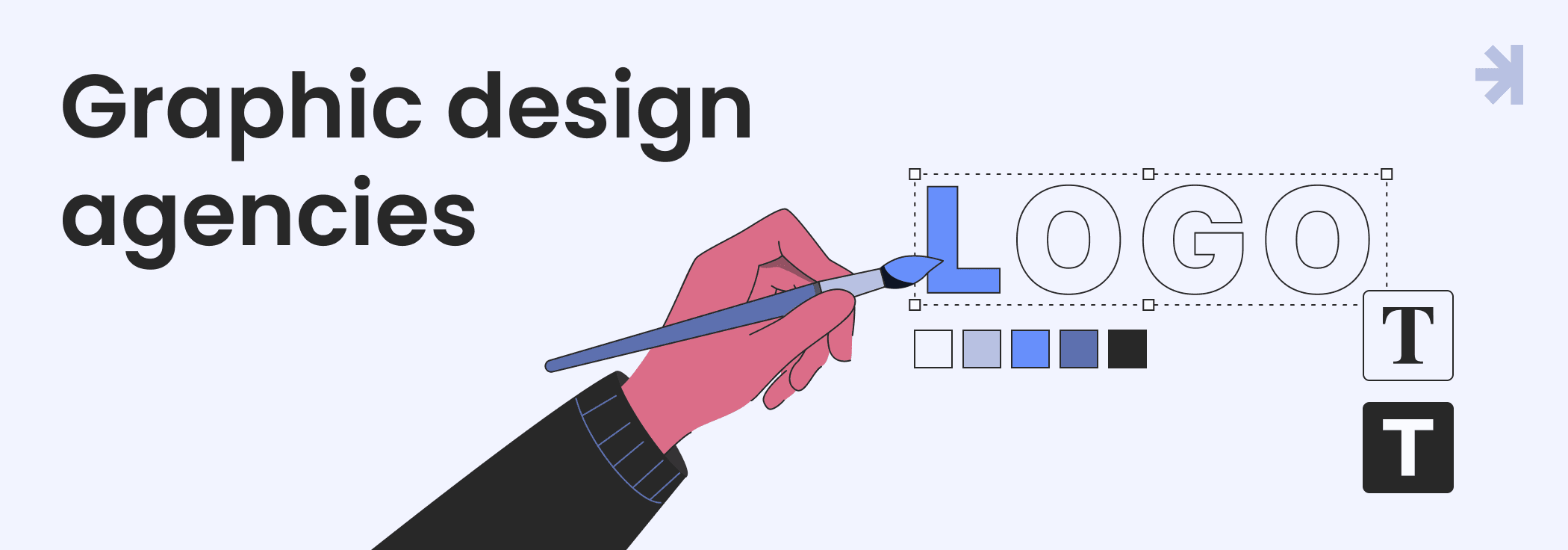
Graphic design agencies
A graphic design agency is a digital agency that specializes in crafting compelling visuals that make brands recognizable and memorable. Logo design or digital graphics are among the typical services they provide.
These agencies also generate images for digital marketing across channels, whether social media posts or website banners. In an Instagram post, designers might throw together some snazzy captions and graphics overlays to grab people’s attention. Or they can produce sleek infographics on industry trends for a report on a company website.
The reach of a graphic design agency goes beyond digital channels. Designers can just as well work on retail packaging and label design. They often work closely on print design for brochures, flyers, and signage.
While a graphic design agency focuses on visual brand recognition and creates consistent design components like color palettes, typography choices, and imagery, branding firms go even further.
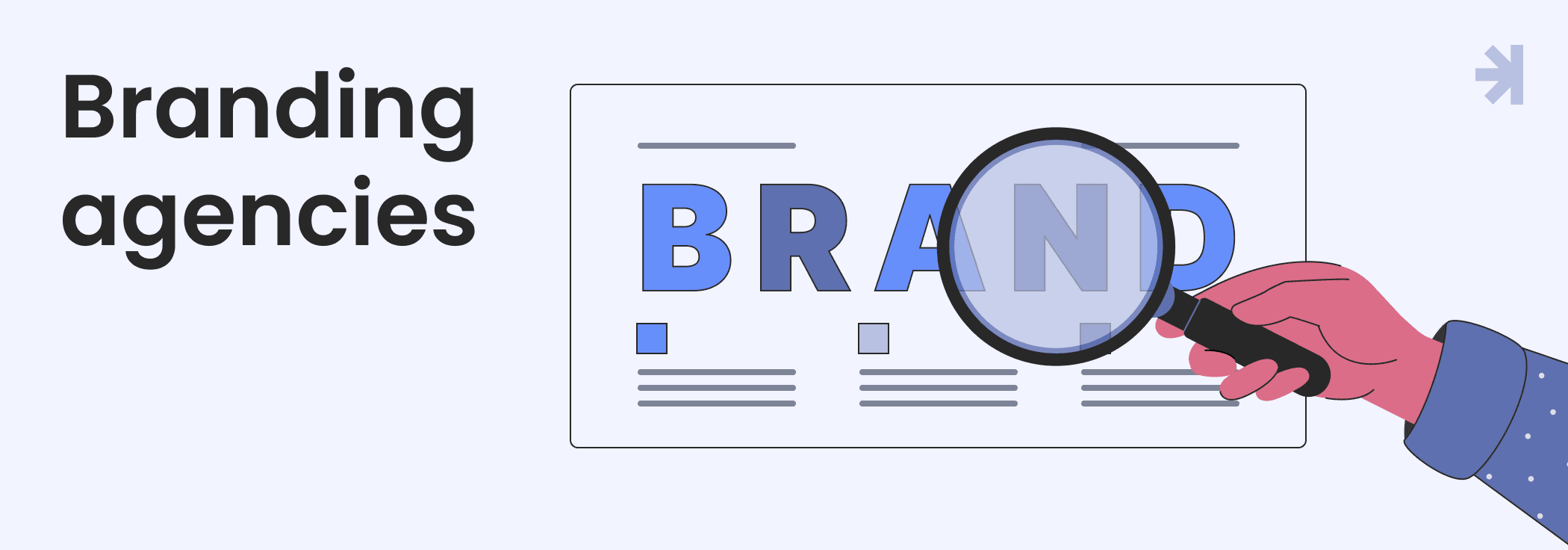
Branding agencies
Branding agencies do not just provide graphic design services. They dig deep into the brand’s ethos. These firms round the design out with brand strategy, positioning, guidelines, messaging, and other branding services.
These agencies often have a diverse team structure covering a wide range of consulting services. Typical roles include strategy leaders, brand strategists, user research experts, digital marketing experts, creative writers, and graphic designers.
Here are the most typical branding design agency services:
- Brand vision and positioning. A branding agency determines the brand’s target audience, values, and core personality.
- Research and analysis. Research experts do consumer analysis and competitor audits.
- Identity design. It covers visual assets such as logos, typography, and color palettes that visually symbolize the brand.
- Brand messaging. A branding agency decides what marketing language and key messages the brand should use in its digital campaigns and content.
- Brand guidelines development. Brand guidelines help maintain consistency wherever the brand is presented.
In short, branding firms create compelling visuals and shape the brand's verbal and experiential communication matching the overall strategy. However, branding agencies are too often mistaken for another popular type of digital agencies.
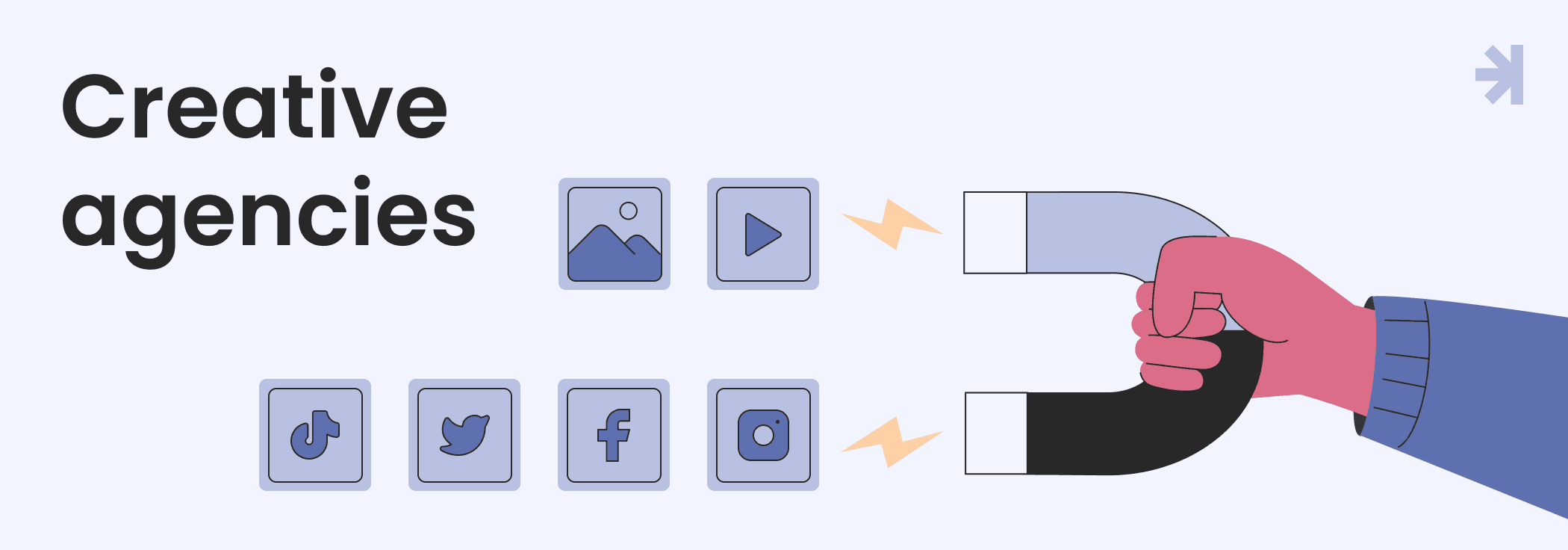
Creative agencies
Branding and creative firms both help build and promote brands, but their core services differ. While branding agencies work on core branding, creative firms prioritize campaign-specific solutions. Still, some agencies might use the titles “branding” and “creative” interchangeably.
A creative agency generates impactful content that promotes your business in the short term and is often tied to specific projects, like seasonal product launch campaigns.
It usually focuses on a wider scope of services, too. Along with graphic design services, it spans social media marketing, video production, and photography. Teams vary depending on the project but typically follow a highly collaborative, multidisciplinary approach.
The first three types of design agencies cater to physical and online presence and cover marketing services. Now, let's zero in on agencies that focus solely on digital product design services.

Web design agencies
Web design agencies do exactly what their name suggests — they design websites. Unlike web development companies, which concentrate on functionality, web design companies care the most about the look, feel, and site navigation.
Web designers map out the site architecture and user flows and ensure that visitors can easily find the necessary information and take whatever action they need. They prioritize layout, color scheme, typography, and graphics to make the website aesthetically pleasing.
Beyond these core design services, some agencies offer extra strategic value. This can include providing research-backed recommendations on conversions, user interactions, and information architecture.
When looking for a design partner to work on your digital product, you might also come across product design firms. Let's explore what sets them apart.
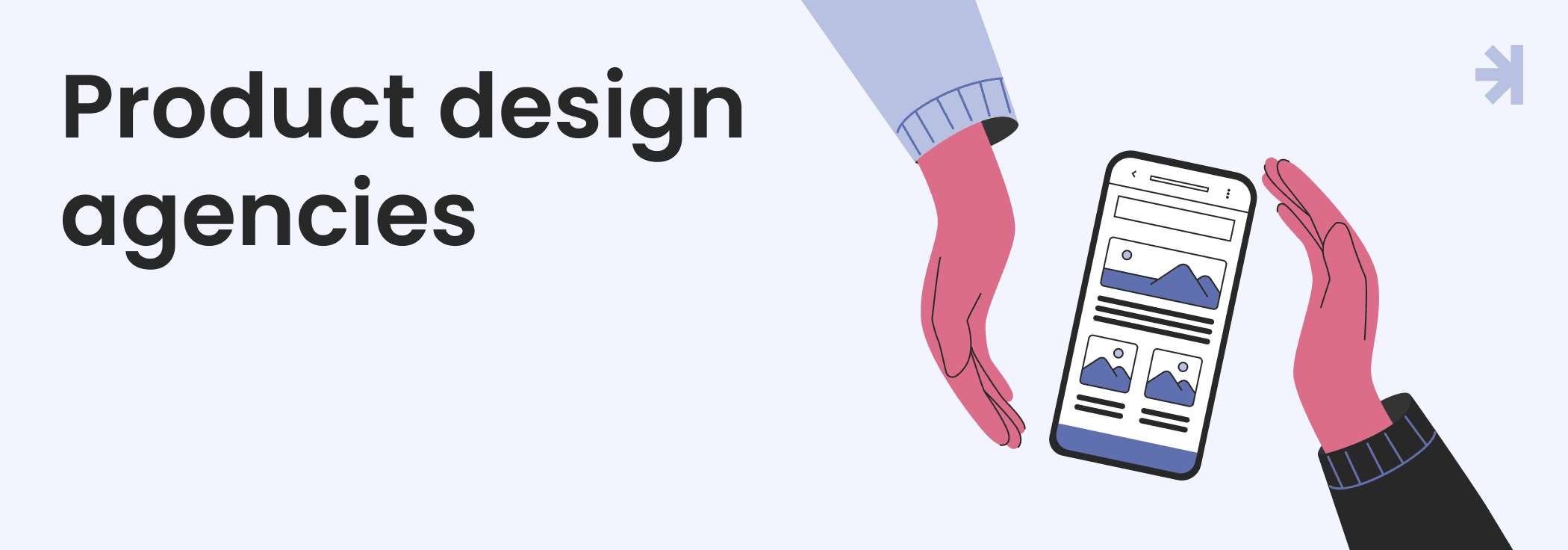
Product design agencies
A product design agency and a web design agency can both provide design services for digital products. The main differences have to do with the scope and focus of the designs.
Product design agencies take a more expansive approach across all products within a company. They design integrated user experiences across the entire customer journey, spanning multiple different products like websites, native mobile apps (iOS, Android), SaaS software, and even backend systems.
Therefore, the main role of a product design agency is to take a big picture view to design seamless user experiences across all products a company offers. However, any digital agency obsesses over user perspectives to the same degree as UI/UX firms do.
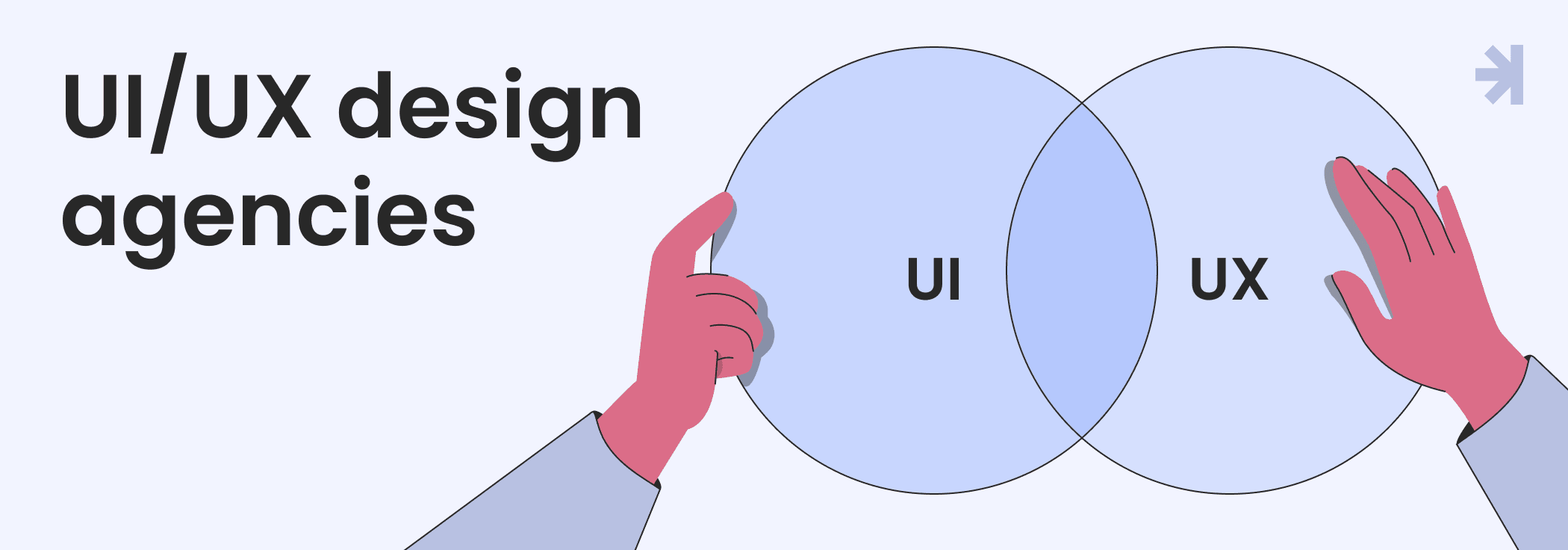
UI/UX design agencies
Remember the last time you pulled up your Uber app and got a ride in just three taps? Behind that easy user flow is the work of user interface and user experience designers. Just like product design firms, UI/UX agencies work on all types of digital products — websites, web apps, mobile apps, SaaS products, etc.
However, UI/UX firms go deeper than just designing user interfaces and expand into the following areas:
- Product strategy and positioning: determining a digital product's vision, roadmap, and messaging based on customer needs analysis, market research, and business goals.
- Brand identity design: crafting visual brand assets that communicate the product’s personality and enhance recognition across multiple touchpoints.
- Content strategy: planning the purpose, voice, tone, and messaging used in copy across interfaces to educate and engage users.
A core part of UX design involves researching user needs and pain points. First, UX researchers use competitor analysis, customer interviews and surveys, and usability testing to determine user requirements.
Next, interaction designers define how exactly the target audience will engage with the product. They map out intuitive flows for different use cases. Visual designers then turn initial wireframes into appealing designs aligned with brand style guides. High-fidelity, interactive prototypes simulate the final product so the client can validate the concept before launch.
Before development kicks off, UI/UX firms also test prototypes with real target users to get feedback for further UI and UX refinement. Top-tier agencies optimize their designs post-launch through experiments and ongoing research.
When choosing a design partner, it’s crucial to clarify which type matches your current business needs. That’s not the only consideration, though.
Identifying your design goals
Agency specialization matters, but it also makes sense to think about your creative needs and specific design goals. These goals can span:
- Increased brand awareness
- Improved conversion rates
- Higher customer satisfaction scores
- And much more
What’s more, all design firms fall into one of two camps in terms of their approach to design implementation.
One group gets work done quickly following your instructions. The other group acts more like a design partner shaping strategy and vision alongside you.
Figuring out which camp a company belongs to might be tricky due to varying names and design agency services advertised. That’s why clarifying the outcomes you expect from your design partner before you shake hands with an agency is so important.
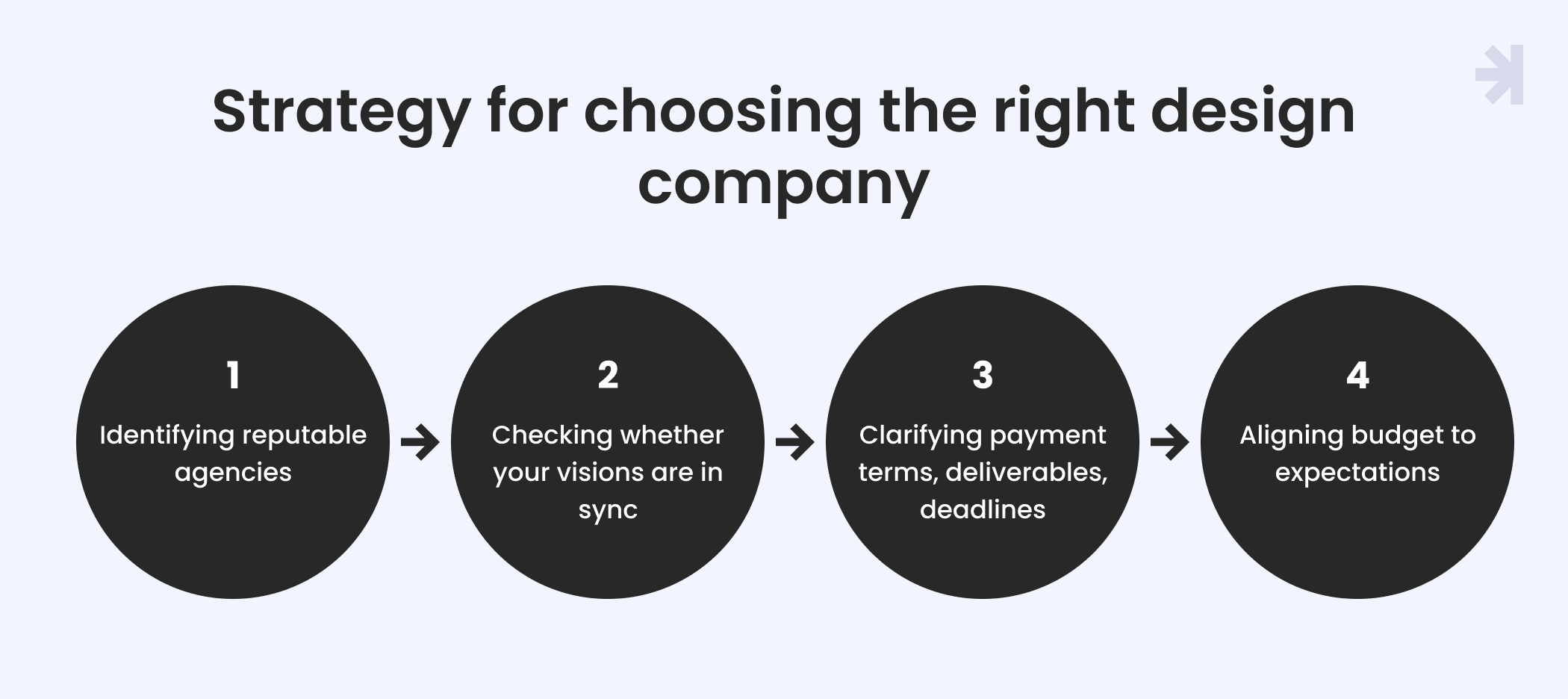
Strategy for choosing the right design company
Framing design objectives is essential, but that alone doesn’t guarantee success in choosing the most suitable company. These tasks remain on your to-do list:
- Identifying reputable agencies
- Checking whether your visions are in sync
- Clarifying deliverables, deadlines, and payment terms
- Aligning budget to expectations
To facilitate this process, we recommend filtering potential agencies based on these five criteria:
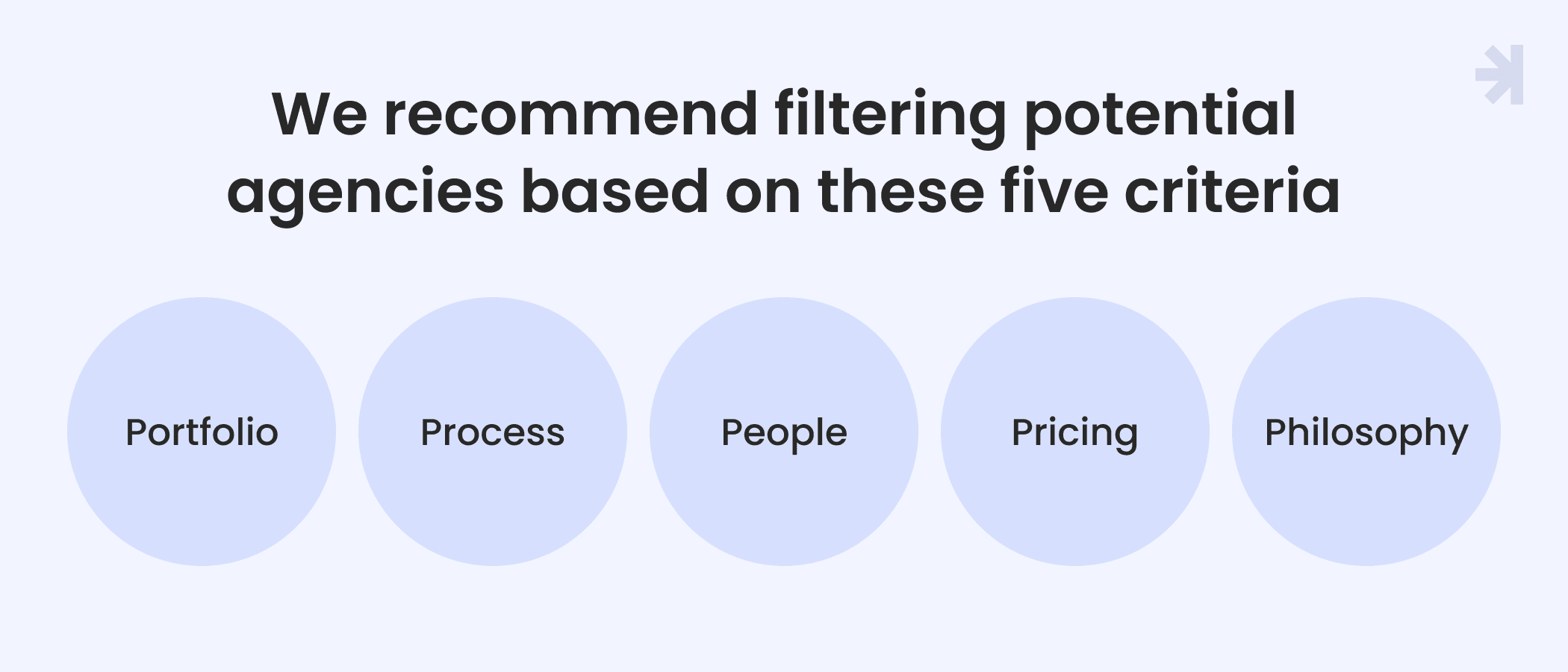
- Portfolio. Above all, a portfolio shows concrete proof of the agency’s abilities. Put together a shortlist of agencies whose designs appeal to you. Pay special attention to projects within your industry and cases similar to yours.
- Process. Ask the agency specific questions about its typical workflow, project pacing, toolsets, and communication structures. Check whether their design process suits your own approach and business needs.
- People. Look beyond the sales pitch and get to know the people who will be doing the actual work. Seek designers and developers who share your enthusiasm for making great products with compelling user experience.
- Pricing. Get quotes from all the agencies you’re considering. The cost shouldn’t be the decisive factor, but knowing the rates early helps rule out a big mismatch.
- Philosophy. Top design agencies drive business results through human-centered design, not just good look and feel. So, make sure you’re on the same page philosophically.
Finally, as you evaluate agencies, compile your findings into an apples-to-apples comparison chart around key factors aligned with your business goals. A visual map will help you make an informed choice rather than rely solely on a convincing sales pitch or impulsive decision.
Conclusion
So there we have it — an inside look at the inner workings of design firms and how to find the perfect fit for your next project. Take time to clearly lay out your business goals. Then, seek out an company with extensive experience in your industry that matches your style and budget.
Reputation and price tag matter, but strategic approach matters more. Remember to ask questions early on to understand how your potential partner operates.
Contact our dedicated team if your business seeks to create category-defining experiences. At MagicFlux, we do more than just design products — we design solutions that shape relationships between your brand and your users and connect with them on a deeper level.
FAQ
1. What is a design agency?
A design agency is a group of designers and other experts from various disciplines (graphics, branding, digital design, etc.) who team up to help brands develop all kinds of visual solutions, from logos to advertising campaigns to software designs.
2. What types of design agencies are out there?
The most common types are graphic, branding, creative, web, UI/UX, and product design companies. Most of them offer a mix of creativity, strategy, tech know-how, and other expertise to tackle various projects.
3. How do I find a good design agency?
Look at their experience in your industry and check out their portfolios and client reviews. A good design agency cares not only about aesthetics but also understands the role of design in the company’s business strategy.
4. What are some important questions to ask a design agency?
Start by asking about the agency’s creative process and expertise in your particular industry. That said, you have to do your homework first and determine the project scope, timing, budget, and other details. This will help you set clear expectations for your digital transformation and find the design partner who fits the job.
